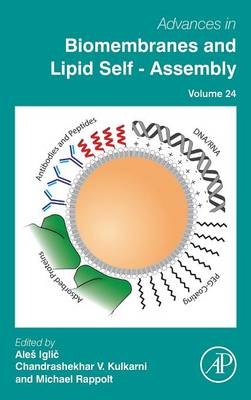
Advances in Biomembranes and Lipid Self-Assembly
Academic Press Inc (Verlag)
978-0-12-804708-8 (ISBN)
Planar lipid bilayers are widely studied due to their ubiquity in nature and find their application in the formulation of biomimetic model membranes, and in the design of artificial dispersion of liposomes.
Moreover, lipids self-assemble into a wide range of other structures, including micelles and the liquid crystalline hexagonal and cubic phases. Consensus has been reached that curved membrane phases do play an important role in nature as well, especially in dynamic processes, such as vesicles fusion and cell communication. Self-assembled lipid structures have enormous potential as dynamic materials ranging from artificial lipid membranes to cell membranes, from biosensing to controlled drug delivery, from pharmaceutical formulations to novel food products to mention a few.
An assortment of chapters in this volume represents both original research as well as comprehensive reviews written by world leading experts and young researchers.
Aleš Iglič received his B.Sc. and Ph.D. degrees in physics and M.Sc. degree in biophysics from the Department of Physics, and the Ph.D. degree in electrical engineering from the Faculty of Electrical Engineering, all from the University of Ljubljana. He is a Full Professor and the Head of Laboratory of Biophysics of the Faculty of Electrical Engineering at University of Ljubljana. His main research interests are in electrostatics, mechanics and statistical physics of lipid nanostructures and biological membranes. He is devoted to higher education, basic research in biophysics and close contacts to clinical practice. Prof. Iglič was visiting scientist and professor at Åbo Academy University in Turku (Finland), Friedrich Schiller University in Jena (Germany) and Czech Technical University in Prague (Czech Republic). He established collaborations with researchers from different universities across the Europe, USA and India and was supervisor of many M.Sc., Ph.D. and postdoctoral students from Slovenia, Czech Republic, Poland, Iran, Bulgaria, Germany, India and Israel. Since 2009 is the editor of Elsevier book series »Advances in Planar Lipid Bilayers and Liposomes« (APLBL). Chandrashekhar V. Kulkarni received his PhD in Chemical Biology from University of London for which he was in receipt of a Marie Curie Early Stage Researcher Fellowship at Imperial College London (2005-2008). Earlier he completed his BSc (1999) and MSc (2001) in Chemistry from Shivaji University Kolhapur, India and started his research career at the National Chemical Laboratory Pune, India. He had a few postdoc stints at University of Graz-Austria, University of Bayreuth-Germany and University of Cambridge-UK during which he worked on a wide range of projects. In March 2013 Dr Kulkarni started ‘Lipid Nanostructures Group’ focussing on highly interdisciplinary and cutting-edge projects. Some of his research interests include complex biomembranes and biomolecule interactions, nanostructured lipid particles as carrier systems, and novel nano-bio-applications of lipid nanostructures. Dr Kulkarni joined the editorial board of APLBL in early 2013 and later as an editor of this book series. Michael Rappolt has been appointed as Professor of Lipid Biophysics (School of Food Science and Nutrition) in April 2013. He received his MSc and PhD in physics from the University of Hamburg and achieved his habilitation at the University of Ljubljana in the Faculty of Health Sciences. He was Senior Researcher at the Synchrotron Trieste Outstation (Italy), Institute of Biophysics and Nanosystems Research (Austrian Academy of Sciences), before becoming Assistant Professor at Graz University of Technology. Professor Michael Rappolt is a leading authority on investigating the structure and dynamics of lipid membranes using small-angle X-ray scattering. His recent research activities have concentrated on the study of drug/membrane interactions with potential applications to drug delivery and food. Further research topics concentrate on characterising crystallization processes in food, the investigation of colloid interfaces and the determination of particle structures on the nanoscale. He also seeks to transfer standard measurement techniques applied in food research – such as mechanic (sound and shear) and thermodynamic sample manipulations to synchrotron sites – to understand food on a smaller (nanometre) and faster (microsecond) scale.
1. How Lipid Cores Affect Lipid Nanoparticles as Drug and Gene Delivery SystemsAllan Radaic, Leandro Ramos Souza Barbosa, Carlos Jaime, Yvonne L. Kapila, Francisco Benedito Teixeira Pessine and Marcelo Bispo de Jesus2. Strategies for Exploring Electrostatic and Non-Electrostatic Contributions to the Interaction of Helical Antimicrobial Peptides with Model MembranesDayane S. Alvares, Márcia Perez Dos Santos Cabrera and João Ruggiero Neto3. Using High Pressure to Modulate Lateral Structuring in Model Lipid MembranesNicola L. C. McCarthy and Nicholas J. Brooks4. Memristors in BiomembranesAlexander G. Volkov and Vladislav S. Markin5. Morphological Transitions in Surfactant Bilayer SystemYuji Yamashita6. Polymeric Micellar Structures for Biosensor TechnologySudheesh K. Shukla, Penny Govender and Ashutosh Tiwari7. TiO2 Nanostructures in BiomedicineRoghayeh Imani, Veronika Kralj-Iglic and Aleš Iglic
| Erscheinungsdatum | 22.08.2016 |
|---|---|
| Reihe/Serie | Advances in Biomembranes and Lipid Self-Assembly |
| Verlagsort | San Diego |
| Sprache | englisch |
| Maße | 152 x 229 mm |
| Gewicht | 450 g |
| Themenwelt | Naturwissenschaften ► Biologie ► Biochemie |
| Naturwissenschaften ► Chemie | |
| ISBN-10 | 0-12-804708-9 / 0128047089 |
| ISBN-13 | 978-0-12-804708-8 / 9780128047088 |
| Zustand | Neuware |
| Haben Sie eine Frage zum Produkt? |
aus dem Bereich


